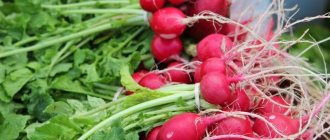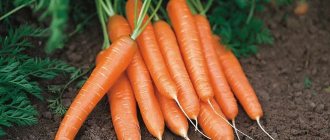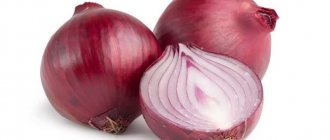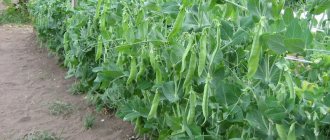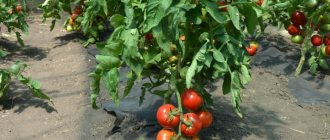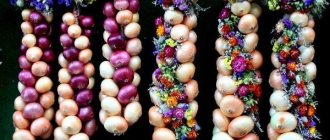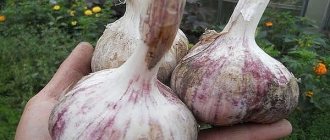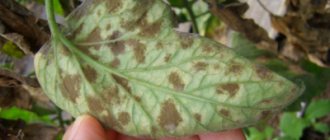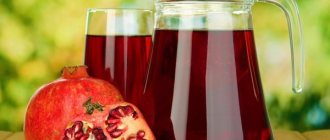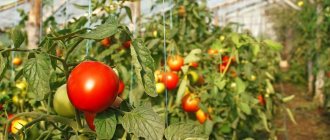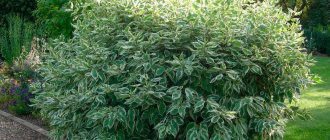What and how affects the winter storage of onion sets
If you still have bulbs after autumn planting, you purchased planting material in late autumn or winter, or you grew seedlings from seeds yourself, it’s time to prepare the seedlings for long winter storage. Don't worry, it's not difficult and I'll tell you how to do it.
What is important to consider:
- The bulbs should be dried, dense, without rot.
- The air temperature in the room selected for storage must be the same.
- Humidity – no more than 65%.
In the next video you can see the process of preparing seedlings for storage and learn some secrets.
If it starts to rot
To prevent onion sets from starting to rot, you need to follow all storage recommendations:
- Correct preparation process.
- Specified room temperature.
- Humidity percentage.
- Regularity of ventilation.
- The right storage container.
If the set suddenly begins to rot, it can still be saved. Separate rotten or infected husks from it. If the set has been severely affected by rotting, you can completely remove all the skin from it. During storage, the husk will again cover the onion and it will be possible to plant it in the spring.
In winter, you should definitely look at the sets. If it is clear that the onions are rotting, they are removed from the main raw material.
Varieties that do not have high shelf life include Stardust onions, which you can read about here.
Check the husk by touch. If it becomes wet, the onion must be dried.
How to prepare bulbs for storage before planting
In my opinion, the main thing is to collect the hay on time and dry it properly. This will ensure long-term storage. I do this in the first half of August, when the arrows of the bow turn yellow and fall to the ground. I collect them on a sunny, dry day and immediately lay the bulbs out on the veranda to dry.
I recommend choosing ventilated places for drying, protected from rain. An open shed on the street, a veranda, an attic, or a dry shed are suitable. Our main task is to thoroughly dry the onions.
It takes me 1.5 - 2 weeks to dry. All this time I mix the bulbs and turn them over so that the bottom layer does not become damp and rot.
When I see that the onion is dry: there is no dampness and pieces of stuck undried earth, I start cleaning it. I tear off the dry roots and arrows. I just do it with my hands, without much effort. I put all damaged heads that are starting to rot aside.
Author's note
Natalia Papanova
Blog author
When preparing for storage, do not cut off the roots and arrows with scissors. By damaging the bulb, we give access to the pulp to harmful bacteria that cause rot.
Now it's time to calibrate the bulbs. I usually get 3 piles of onions, different in size:
- The first is heads measuring less than 1 cm in diameter. They will not grow into a full-fledged bulb. I plant them in the garden bed for the winter, so they grow stronger and produce fresh feathers in the spring.
- The second is what is suitable for planting on a turnip. The diameter of the bulbs should be 1 - 2.5 cm.
- The third is an overgrown onion, larger than 2.5 cm. I also store it until spring and plant it on a feather.
If you love greens, read how I grow green onions! He keeps me happy with vitamins all winter without going to the store.
Sets collected in the fall for storage
How to properly store onion sets until spring
I used to worry about how to maintain constant temperature and humidity to store seeds at home. For a long time, this thought made me refuse to store seed sets at home. And since I had no other option, I had to buy hay in the spring at exorbitant prices.
In fact, everything is simple: central heating in our apartments allows us to maintain approximately the same temperature and humidity. I just choose a cooler corner for storage: a corridor, vestibule or closet.
This is what different varieties of onion sets look like
Temperature
The optimal storage temperature is from 17 to 25 degrees. To determine a suitable location, I first measure the temperature with a household thermometer in different parts of the apartment.
At temperatures below 17 degrees, a process that is invisible to the eye occurs in the bulbs. The rudiment of a peduncle is laid inside, which then, upon germination, turns into an arrow.
If you have any doubts that the temperature in the apartment is stable, I suggest storing the onions in the refrigerator in the vegetable compartment.
Do you store onion sets?
Not really
Humidity
In houses with central heating, the humidity is always constant. Remember how often we try to humidify the air in our apartments in order to feel more comfortable. Suitable humidity for storage is 50-65%.
To determine humidity, I recommend purchasing a hygrometer. This is a simple device, sold in hardware stores.
And there are ways to determine the humidity in the house using improvised means. I want to share one of them with you. I do this:
- I take a regular glass glass, fill it with water and put it in the refrigerator for 2 hours.
- I take the glass out of the refrigerator and measure the temperature of the water. It should be 50 degrees, no more.
- I put the glass in a place away from the central heating radiators and for 5-10 minutes. I’m watching what happens to the condensation that has formed on the outer walls of the glass. If the glass dries quickly, then the air is dry. If the surface remains damp, the humidity is normal. If the water begins to flow in streams, the air humidity is increased.
To store the sets, you will need to maintain average humidity. And if your home has above average humidity, then I think you will be interested in learning how I grow bay leaves at home.
Air circulation
Ventilation is salvation from malicious rot, which can destroy the entire onion. First of all, I recommend packing seedlings for storage in breathable material (I’ll talk about this below) and placing the seedlings in places where there is normal air circulation.
I always store my onions on the hallway cabinet. Pros:
- There are no batteries or direct sunlight nearby.
- Excellent ventilation, as the front door opens periodically and the air does not stagnate.
- The humidity is constant (note that I have a long hallway and there is no bathroom next to the closet).
- It’s easy to take out, shake the onion and check for rot.
Combined method
This method combines both of the previous ones. It consists in the fact that the temperature changes periodically during onion storage. From the time of collection until the onset of winter, the storage temperature should be +18-20 degrees.
At the first cold snap, the temperature is reduced to 0-3 degrees, and in the spring the seedlings are removed to a warm place, where temperature values can range from +20 to +23 degrees.
Before planting, the bulbs are heated in the same way as with the cold method.
If you comply with all storage conditions, in the spring the seedlings will sprout well and will not shoot, and by the end of summer you will be pleased with a rich harvest.
- Author: Inna Kiseleva
Rate this article:
- 5
- 4
- 3
- 2
- 1
(0 votes, average: 0 out of 5)
Share with your friends!
Winter storage methods
You already have a rough idea of how to store onion sets in an apartment and what you need for this.
Also find out how to preserve the onion harvest at home in winter. I want to tell you in more detail about each of the methods so that you can choose the best option for yourself.
Warm way
This method involves storage in an apartment when the temperature can reach 25 degrees Celsius. During the winter heating season, the temperature and humidity in apartments does not change much. It’s good if the temperature is no more than 25 degrees and the humidity does not cross the 65% mark.
If you find it difficult to imagine where to store onions, I suggest choosing places on the closet, mezzanine or under the bed.
When storing at home, I never have any problems with preserving the senile; it tolerates wintering well until spring planting.
Author's note
Natalia Papanova
Blog author
Check the bulbs regularly for dampness and rot.
Next, in the video, you will see how an experienced gardener stores onion sets in an original way, proven over the years:
Cold
The following cold storage options are available:
- Fridge. I wrap clean, calibrated onions in paper or newspaper and place them in the fruit drawer. The onion is stored for a long time, until planting in open ground in the spring.
- Basement. In this case, I usually hang the bags from the ceiling. I believe that this way the onion breathes better and air has access to each onion. But you can put the harvest in boxes on shelves. We maintain the temperature within -3 +6 degrees, and humidity at 75-85%. If all conditions are met, the onion lies perfectly before planting, i.e. from September to May.
- Storage in the ground. This is my grandfather’s proven method, which I also tested once. I took a bucket, poured a 10 cm layer of sawdust on the bottom, then put in the seedlings, then again poured sawdust on top to the top and closed the lid. I dug a hole in the ground so that the bucket could be placed freely and another 15 cm left above the bucket. I dug the bucket in April, when the snow melted and the ground began to warm up.
Author's note
Natalia Papanova
Blog author
Do not store onions in plastic bags or tin containers with lids. This will lead to rotting and death of the entire set.
Combined method of storage of sets
The combined method is a combination of warm and cold storage methods. To preserve the harvest in this way, I do this: until the first cold weather, I keep the onions warm at home. After the first frost, I transfer the bulbs to a cool place. The basement is more suitable for these purposes, where I hang the bags from the ceiling.
When the spring thaw sets in, I bring the onions into the house again and store them at 25 degrees for 5 days. Then, before landing, I maintain 22 degrees.
When humidity changes, onions begin to sprout
Preparation
Preparation for storage includes several stages. First, harvesting onions before storing them for the winter. The seedlings are harvested at the end of August .
In order to be sure that it is fully prepared , pay attention to the tops; they should turn yellow. This is a sure sign that the onion is ripe and time to harvest.
After the onion harvest is harvested, it is sorted and sorted . Whole, rot-free, healthy specimens are selected for storage for the winter. The slightest rotting of one head will result in damage to the entire batch of onions.
Secondly, the seedlings must be thoroughly dried . Drying onions in the open sun gives ideal results. In addition, the sets are dried under a canopy and in a room with excellent ventilation. To dry the set, you need light and air, then its husk will become rustling and dry.
An experienced gardener will share his tips for storing seedlings with you in this video:
Choosing a storage location
Now let's look at the packaging in which we will put the bulbs for storage. The main requirement is “breathable” material.
Using experience, I will say that there is nothing better than proven old methods. This is, of course, keeping it the old fashioned way in a stocking. Ideal for air access to all bulbs. I hang such a bag in a dark place, and it reliably retains all the properties of the planting material.
I’ll tell you below what other types of containers you can use.
Author's note
Natalia Papanova
Blog author
To prevent loss of seedlings during storage, check your supplies at least 2 times a month.
Plastic and wooden boxes
For me, boxes are convenient because you can store a large amount of vegetables in them, while stacking them on top of each other. But I draw your attention to the fact that you need to place the bulbs in a layer of 5-10 cm, no more. At the same time, I sprinkle the onion with dry peels. It regulates humidity and creates spaces for air circulation.
Author's note
Natalia Papanova
Blog author
The bottom of the box must be perforated, otherwise moisture will accumulate at the bottom and the vegetables will begin to deteriorate.
But which box to choose, wood or plastic? Let's look at the table.
| Material | Environmental friendliness | Possibility of processing containers | Resistance to mold and rot | Shelf life |
| Plastic box | Made from synthetic materials | Easy to clean, disinfect, does not absorb foreign odors and vegetable juice | Mold resistant | Maintains the quality of planting material all winter before planting |
| Wooden box | Natural eco-friendly packaging | Difficult to clean, absorbs odors and juice from vegetables. | Unstable. It rots quickly. | Saves one season |
As we can see from the table, the advantages are on the side of the plastic box. Although many professional gardeners categorically reject the use of plastic, its use is quite acceptable, given the characteristics indicated in the table. The choice is yours. If you follow the storage rules, both containers will serve their purpose equally.
Canvas bags
Bags made of breathable fabrics are good for preserving crops. I don’t tie such bags and never place them on the floor so that the bottom layer doesn’t get damp. Periodically, I pour all the onions onto the floor and check them for moisture and specimens that are beginning to rot.
Onions stored in bags are well ventilated and do not rot
Egg containers
In my opinion, it is a very good packaging material that can independently regulate humidity by absorbing excess moisture. When storing this way, I simply pour the onions into the cells. If there are several containers, I stack them on top of each other and put them away on the cabinet.
Egg cassettes are a universal material. Find out how I use them to grow arugula at home, this simple method works well for me.
General rules for storing seedlings in an apartment
If you intend to get a full harvest from your stored onion sets, I recommend you read these tips. I hope they will help you understand how to properly store onion sets before planting:
- give preference to yellow spicy onions;
- Before storing, check that the material is thoroughly dried;
- send for storage dense, undamaged specimens without rot;
- clean the bulbs that have rot, dry them at elevated temperatures and also store them;
- place the senchik on shaded shelves, with temperatures up to 24 degrees and low humidity (up to 75%);
- ventilate the room.
- constantly check the planting material, mix, remove suspiciously wet or rotten bulbs.
Don't like onions? Then check out how to grow lettuce on your windowsill! It does not require much effort in terms of cultivation and care.
FAQ
Natalia Papanova
Blog author
Ask your question
Now let’s turn to the questions that most often arise among novice gardeners.
The sevok is a little rotten - what should I do?
I assure you that you should not be afraid of this. If a small part of the crop is affected, the situation can be saved. I usually select spoiled onions, wash them thoroughly, and clean them. Sometimes remove the onion skins completely to remove rot. Then I let the bulbs dry and store them again in a separate container.
How long can you store seedlings at home?
I never store sets for more than 1 winter. It just dries up by the next season. That is, if you have stored seedlings in the fall, then they must be planted next spring. The suitability of onion senchik as planting material is 1 year. It's simply not possible to harvest from bulbs that last longer.
Which varieties are best stored at home in winter?
Look at the list of varieties that can easily tolerate home storage and produce a full harvest. These are dense yellow onions of sharp varieties: • “Strigunovsky” • “Spassky” • “Ellan” • “Chalcedony” • “Stuttgarter”
